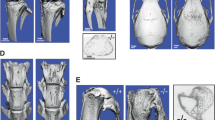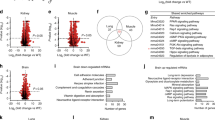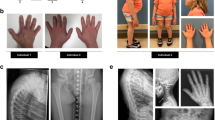Abstract
Paget's disease of bone (PDB) is a common disorder in which focal abnormalities of increased bone turnover lead to complications such as bone pain, deformity, pathological fractures, and deafness. PDB has a strong genetic component and several susceptibility loci for the disease have been identified by genome-wide scans. Mutations that predispose individuals to PDB and related disorders have been identified in four genes. The rare PDB-like syndromes of familial expansile osteolysis, early-onset familial PDB, and expansile skeletal hyperphosphatasia are caused by insertion mutations in TNFRSF11A, which encodes receptor activator of nuclear factor (NF)κB (RANK)—a critical regulator of osteoclast function. Inactivating mutations in TNFRSF11B, which encodes osteoprotegerin (a decoy receptor for RANK ligand) cause idiopathic hyperphosphatasia, and polymorphisms in this gene seem to increase the risk for classical PDB. Mutations of the sequestosome 1 gene (SQSTM1), which encodes an important scaffold protein in the NFκB pathway, are a common cause of classical PDB. The rare syndrome of hereditary inclusion body myopathy, PDB, and fronto-temporal dementia is caused by mutations in the valosin-containing protein (VCP) gene. This gene encodes VCP, which has a role in targeting the inhibitor of NFκB for degradation by the proteasome. Several additional genes for PDB remain to be discovered, and it seems likely that they will also involve the RANK−NFκB signaling pathway or components of the proteasomal processing of this pathway, underscoring the critical importance of this signaling pathway in bone metabolism and bone disease.
Key Points
-
Paget's disease of bone (PDB) has a strong genetic component and is often inherited as a simple autosomal dominant trait
-
Mutations in four genes have been described that cause PDB or related disorders, and all are involved in the receptor activator of nuclear factor κB signaling pathway
-
Classical PDB is commonly caused by mutations in the gene encoding sequestosome 1 (SQSTM1); these mutations cause the sequestosome 1 protein (p62) to lose its ability to bind ubiquitin
-
Several other genes responsible for PDB remain to be discovered and it seems likely that mutations in these genes will also affect the receptor activator of nuclear factor κB signaling pathway
This is a preview of subscription content, access via your institution
Access options
Subscribe to this journal
Receive 12 print issues and online access
$209.00 per year
only $17.42 per issue
Buy this article
- Purchase on Springer Link
- Instant access to full article PDF
Prices may be subject to local taxes which are calculated during checkout

Similar content being viewed by others
References
Meunier PJ et al. (1980) Bone histomorphometry in Paget's disease. Quantitative and dynamic analysis of pagetic and nonpagetic bone tissue. Arthritis Rheum 23: 1095–1103
Friedrichs WE et al. (2002) The pro and con of measles virus in Paget's disease: pro. J Bone Miner Res 17: 2293
Rima BK (2002) The pro and con of measles virus in Paget's disease: con. J Bone Miner Res 17: 2290–2292
Cooper C et al. (1999) The epidemiology of Paget's disease in Britain: is the prevalence decreasing? J Bone Miner Res 14: 192–197
Altman RD et al. (2000) Prevalence of pelvic Paget's disease of bone in the United States. J Bone Miner Res 15: 461–465
van Staa TP et al. (2002) Incidence and natural history of Paget's disease of bone in England and Wales. J Bone Miner Res 17: 465–471
Rogers J et al. (2002) Paget's disease in an archeological population. J Bone Miner Res 17: 1127–1134
Cundy HR et al. (2004) Paget's disease of bone in New Zealand: continued decline in disease severity. Calcif Tissue Int 75: 358–364
Tiegs RD et al. (2000) Long-term trends in the incidence of Paget's disease of bone. Bone 27: 423–427
Gennari L et al. (2005) Prevalence of Paget's disease of bone in Italy. J Bone Miner Res 20: 1845–1850
Siris ES (1994) Epidemiological aspects of Paget's disease: family history and relationship to other medical conditions. Semin Arthritis Rheum 23: 222–225
Solomon LR (1979) Billiard-player's fingers: an unusual case of Paget's disease of bone. Br Med J 1: 931
Montagu MFA (1949) Paget's disease (osteitis deformans) and hereditary. Am J Hum Genet 1: 94–95
Hocking L et al. (2000) Familial Paget's disease of bone: patterns of inheritance and frequency of linkage to chromosome 18q. Bone 26: 577–580
Morales-Piga AA et al. (1995) Frequency and characteristics of familial aggregation of Paget's disease of bone. J Bone Miner Res 10: 663–670
Siris ES et al. (1991) Familial aggregation of Paget's disease of bone. J Bone Miner Res 6:495–500
Sofaer JA et al. (1983) A family study of Paget's disease of bone. J Epidemiol Community Health 37: 226–231
Eekhoff EW et al. (2004) Familial Paget's disease in The Netherlands: occurrence, identification of new mutations in the sequestosome 1 gene, and their clinical associations. Arthritis Rheum 50: 1650–1654
Hocking L et al. (2002). Domain-specific mutations in sequestosome 1 (SQSTM1) cause familial and sporadic Paget's disease. Hum Mol Genet 11: 2735–2739
Barker DJ (1984) The epidemiology of Paget's disease of bone. Br Med Bull 40: 396–400
Osterberg PH et al. (1988) Familial expansile osteolysis. A new dysplasia. J Bone Joint Surg Br 70: 255–260
Nakatsuka K (2003) Phenotypic characterization of early onset Paget's disease of bone caused by a 27-bp duplication in the TNFRSF11A gene. J Bone Miner Res 18: 1381–1385
Whyte MP and Hughes AE (2002) Expansile skeletal hyperphosphatasia is caused by a 15-base pair tandem duplication in TNFRSF11A encoding RANK and is allelic to familial expansile osteolysis. J Bone Miner Res 17: 26–29
Whyte MP et al. (2002) Osteoprotegerin deficiency and juvenile Paget's disease. N Engl J Med 347: 175–184
Kovach MJ et al. (2001) Clinical delineation and localization to chromosome 9p13.3-p12 of a unique dominant disorder in four families: hereditary inclusion body myopathy, Paget disease of bone, and frontotemporal dementia. Mol Genet Metab 74: 458–475
Tilyard MW et al. (1982) A probable linkage between familial Paget's disease and the HLA loci. Aust NZ J Med 12: 498–500
Hughes AE et al. (1994) Genetic linkage of familial expansile osteolysis to chromosome 18q. Hum Mol Genet 3: 359–361
Laurin N et al. (2001) Paget disease of bone: mapping of two loci at 5q35-qter and 5q31. Am J Hum Genet 69: 528–543
Hocking LJ et al. (2001) Genomewide search in familial Paget disease of bone shows evidence of genetic heterogeneity with candidate loci on chromosomes 2q36, 10p13, and 5q35. Am J Hum Genet 69: 1055–1061
Good DA et al. (2001) Linkage of Paget disease of bone to a novel region on human chromosome 18q23. Am J Hum Genet 70: 517–525
Cundy T et al. (2002) A mutation in the gene TNFRSF11B encoding osteoprotegerin causes an idiopathic hyperphosphatasia phenotype. Hum Mol Genet 11: 2119–2127
Teitelbaum SL (2000) Bone resorption by osteoclasts. Science 289: 1504–1508
Hughes AE et al. (2000) Mutations in TNFRSF11A, affecting the signal peptide of RANK, cause familial expansile osteolysis. Nat Genet 24: 45–48
Palenzuela L et al. (2002) Familial expansile osteolysis in a large Spanish kindred resulting from an insertion mutation in the TNFRSF11A gene. J Med Genet 39: E67
Johnson-Pais TL et al. (2003) Identification of a novel tandem duplication in exon 1 of the TNFRSF11A gene in two unrelated patients with familial expansile osteolysis. J Bone Miner Res 18: 376–380
Sparks AB et al. (2001) Mutation screening of the TNFRSF11A gene encoding receptor activator of NF kappa B (RANK) in familial and sporadic Paget's disease of bone and osteosarcoma. Calcif Tissue Int 68: 151–155
Wuyts W et al. (2001) Evaluation of the role of RANK and OPG genes in Paget's disease of bone. Bone 28: 104–107
Nellissery MJ et al. (1998) Evidence for a novel osteosarcoma tumor-suppressor gene in the chromosome 18 region genetically linked with Paget disease of bone. Am J Hum Genet 63: 817–824
B Chong (2003) Idiopathic hyperphosphatasia and TNFRSF11B mutations: relationships between phenotype and genotype. J Bone Miner Res 18: 2095–2104
Hocking LJ et al. (2004) Novel UBA domain mutations of SQSTM1 in Paget's disease of bone: genotype phenotype correlation, functional analysis and structural consequences. J Bone Miner Res 19: 1122–1127
Good DA et al. (2004) Identification of SQSTM1 mutations in familial Paget's disease in Australian pedigrees. Bone 35: 277–282
Johnson-Pais TL et al. (2003) Three novel mutations in SQSTM1 identified in familial Paget's disease of bone. J Bone Miner Res 18: 1748–1753
Beyens G et al. (2004) Evaluation of the role of the SQSTM1 gene in sporadic Belgian patients with Paget's disease. Calcif Tissue Int 75: 144–152
Ciani B et al. (2003) Structure of the UBA domain of p62 (SQSTM1) and implications for mutations which cause Paget's disease of bone. J Biol Chem 278: 37409–37412
Cavey JR et al. (2005) Loss of ubiquitin-binding associated with Paget's disease of bone p62 (SQSTM1) mutations. J Bone Miner Res 20: 619–624
Layfield R and Hocking LJ (2004) SQSTM1 and Paget's disease of bone. Calcif Tissue Int 75: 347–357
Chen ZJ (2005) Ubiquitin signalling in the NFkB pathway. Nat Cell Biol 7: 758–766
Laurin N et al. (2002) Recurrent mutation of the gene encoding sequestosome 1 (SQSTM1/p62) in Paget disease of bone. Am J Hum Genet 70: 1582–1588
Lucas GJ et al. (2005) Ubiquitin-associated domain mutations of SQSTM1 in Paget's disease of bone: evidence for a founder effect in patients of British descent. J. Bone Miner Res 20: 227–231
Duran A et al. (2004) The atypical PKC-interacting protein p62 is an important mediator of RANK-activated osteoclastogenesis. Dev Cell 6: 303–309
Daroszewska A et al. (2004) Susceptibility to Paget's disease of bone is influenced by a common polymorphic variant of osteoprotegerin. J Bone Miner Res 19: 1506–1511
Wang Q et al. (2004) Molecular perspectives on p97-VCP: progress in understanding its structure and diverse biological functions. J Struct Biol 146: 44–57
Watts GD et al. (2004) Inclusion body myopathy associated with Paget disease of bone and frontotemporal dementia is caused by mutant valosin-containing protein. Nat Genet 36: 377–381
Dai RM et al. (1998) Involvement of valosin-containing protein, an ATPase co-purified with IκBα and 26S proteasome, in ubiquitin-proteasome-mediated degradation of IκBα. J Biol Chem 273: 3562–3573
Lucas GJA et al. (2006) Evaluation of the role of valosin-containing protein in the pathogenesis of familial and sporadic Paget's disease of bone. Bone 38: 280–285
Langston AL and Ralston SH (2004) Management of Paget's disease of bone. Rheumatology (Oxford) 43: 955–959
Pei Y (2001) A 'two-hit' model of cystogenesis in autosomal dominant polycystic kidney disease? Trends Mol Med 7: 151–156
Guise TA and Mundy GR (1998) Cancer and bone. Endocr Rev 19: 18–54
Cody JD et al. (1997) Genetic linkage of Paget disease of the bone to chromosome 18q. Am J Hum Genet 61: 1117–1122
Good DA et al. (2004) Identification of SQSTM1 mutations in familial Paget's disease in Australian pedigrees. Bone 35: 277–282
Acknowledgements
This work was supported in part by a program grant to SH Ralston from the Arthritis Research Campaign, UK and by a Medical Research Council clinical training fellowship to A Daroszewska.
Author information
Authors and Affiliations
Corresponding author
Ethics declarations
Competing interests
The authors declare no competing financial interests.
Rights and permissions
About this article
Cite this article
Daroszewska, A., Ralston, S. Mechanisms of Disease: genetics of Paget's disease of bone and related disorders. Nat Rev Rheumatol 2, 270–277 (2006). https://doi.org/10.1038/ncprheum0172
Received:
Accepted:
Issue Date:
DOI: https://doi.org/10.1038/ncprheum0172
This article is cited by
-
A clinicopathologic study of malignancy in VCP-associated multisystem proteinopathy
Orphanet Journal of Rare Diseases (2022)
-
Arginase 1 is a negative regulator of osteoclast differentiation
Amino Acids (2016)
-
The Multiple Faces of Valosin-Containing Protein-Associated Diseases: Inclusion Body Myopathy with Paget’s Disease of Bone, Frontotemporal Dementia, and Amyotrophic Lateral Sclerosis
Journal of Molecular Neuroscience (2011)
-
CYLD: a tumor suppressor deubiquitinase regulating NF-κB activation and diverse biological processes
Cell Death & Differentiation (2010)
-
Paget disease: when to treat and when not to treat
Nature Reviews Rheumatology (2009)



